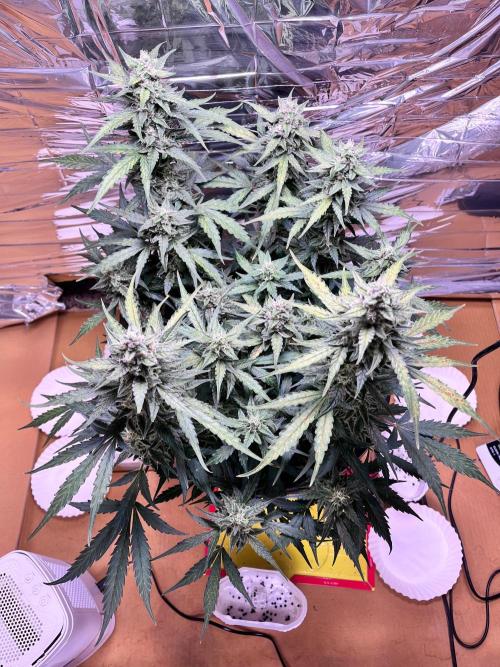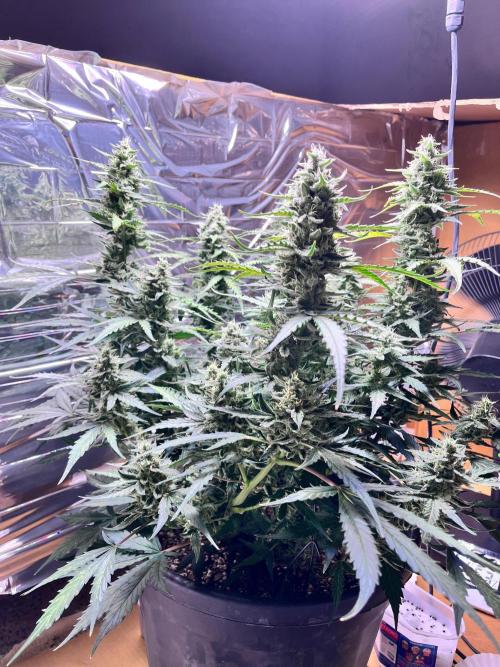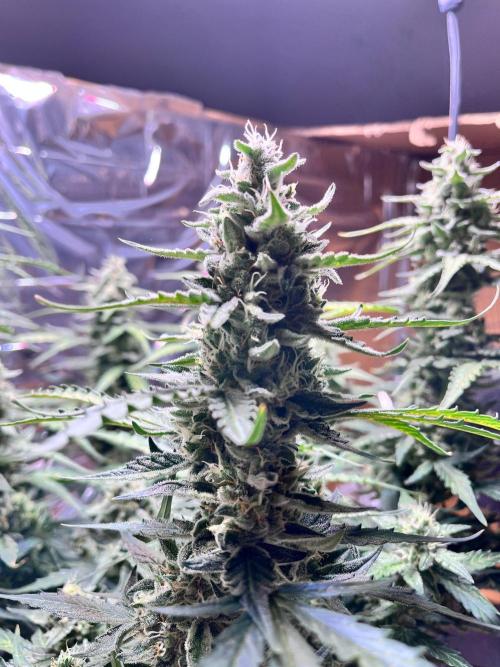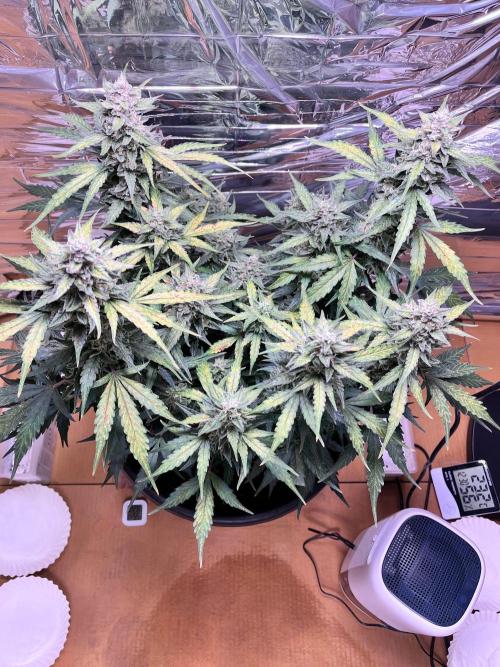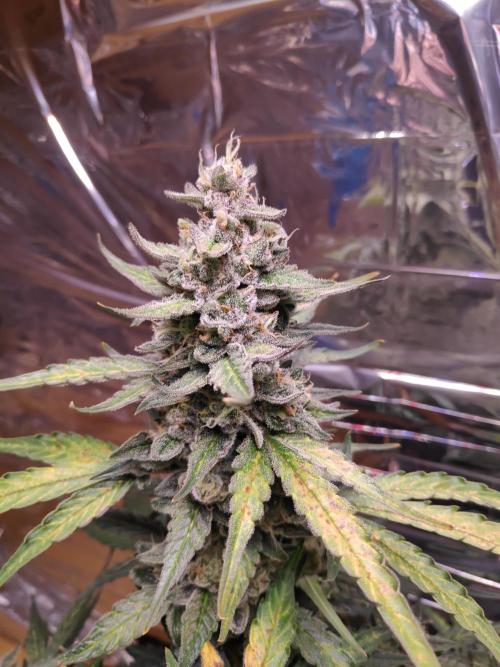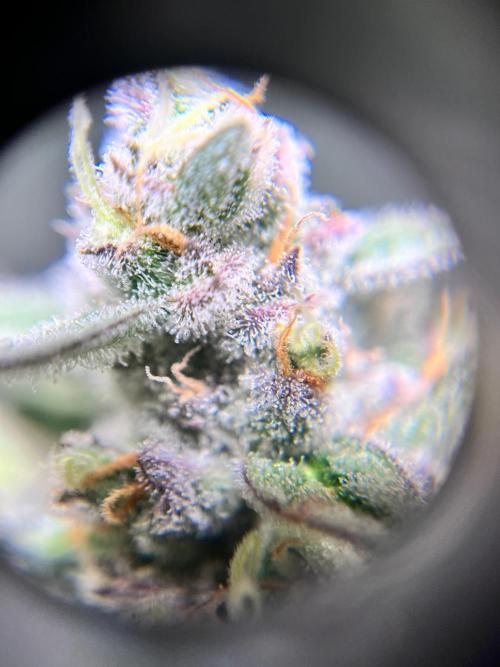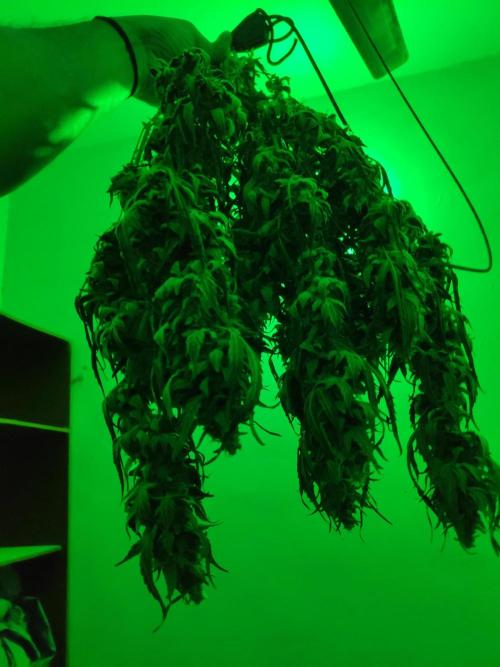The Grow Awards 2026 🏆 


















Auto gorilla

VEG
150watt led grow light Light Emitting Diodes/150W
150watt led grow light
Indoor
Room Type
LST
weeks 3-5, 5, 7-8
Defoliation
weeks 5, 5, 7-8
18 liters
Pot Size
2 liters
Watering
Start at Harvest
G
Germination7mo ago
Mraady FIRST GROW
Seed - 00 SEED
strain - AUTO GORILLA
Day - 4 DAY SINCE SPROUT / 0 WEEK
Soil - FOX FARM HAPPY FROG ( 5 GALLON POT )
LIGHT - 150 WATT FULL SPECTRUM LED GROW LIGHT
TEMP - 27°c
HUMID - 70-80
2 likes
3 comments
Share
Used method
Paper Towel
Germination Method
Grow Questions
Mraadystarted grow question 7mo ago
Hey all its day 6 since sprout should i increase the distance of light or is it good ? As per Manufacturer guide light should be 18 inches from the plant with 40% power in seedling and Its a 150watt full spectrum led grow light
Solved
likes
Mr_Weeds_Autosanswered grow question 7mo ago
Hey Growmie,
18 inches at 40% is a good starting point, Leaf color looks okay, though the newest growth seems a bit pale, which can also be due to low light intensity or slightly off nutrient balance (which isn’t uncommon this early). Try 16–17 inches from the canopy. Monitor the seedling for: Leaf curling or tacoing (too much light) Stretching (still not enough light) Burn or yellowing on leaf edges (too intense) Make small adjustments every 1–2 days based on how the plant responds. Also If you haven’t already, run a gentle breeze over the seedling with a small fan. This helps strengthen the stem and prevents it from falling over if it's stretching.
Mraadystarted grow question 7mo ago
Hey community need help , its day 10 since sprout and tip edges are curling up as the plant is an inch tall now i just adjusted my lights again its 18" from the plant temp is 25-27°c and humid around 70%
Solved
1 like
Mr_Weeds_Autosanswered grow question 7mo ago
Hey! At day 10 since sprout, tip edges curling up could be early signs of light stress or possibly a bit of heat stress, even though your temps (25–27°C) and humidity (70%) look fine. Good move adjusting the light—18” should be safer, depending on your light type. Also, make sure the medium isn’t staying too wet; overwatering at this stage is super common and can cause similar leaf curl. Keep an eye on how she responds over the next 24–48 hours. You’re not far off—she just needs a stable, gentle environment to get rooted strong.
1
Week 1. Vegetation7mo ago
3.81 cm
Height
18 hrs
Light Schedule
26 °C
Day Air Temp
6.5
pH
65 %
Air Humidity
27 °C
Solution Temp
26 °C
Substrate Temp
26 °C
Night Air Temp
18 liters
Pot Size
45.72 cm
Lamp Distance
Mraady FIRST GROW
Seed - 00 SEED
strain - AUTO GORILLA
Day - 12 DAY SINCE SPROUT / 1 WEEK 5 DAYS
Soil - FOX FARM HAPPY FROG ( 18 LITER POT )
LIGHT - 150 WATT FULL SPECTRUM LED GROW LIGHT
TEMP - 26
HUMID - 60-70%
Since sprout its day 12 haven't done much in these 12 days , i have only watered 50ml in 3-4 days interval and as the top most soil was bone dry in 12th i gave 100ml of water and increased my light height to 18" as plant is now 1.5 inch tall , and i have increased light intensity to 70% now from 40% intensity , please guide me if I am doing good and thank u for taking time out and looking over my diary
2 likes
comments
Share
Grow Questions
Mraadystarted grow question 7mo ago
Hey community what could be the reason for curling up of edges of leaf , i am having this issue since starting of grow and now its 12 days from germination even new leaf's show same issue edges curled up a little could it be genetics ? Temp is around 24-27°c and humid is 60-65%
Solved
Leaves. Curl up
likes
Ultravioletanswered grow question 7mo ago
Similar to asking why an athlete has a bead of sweat on his forehead, she looks very healthy, rigid turgor, tells me she is going hard, not too stressful, just right, its a thing of balance to maintain, between cooling over the long 18+ hour days, anytime a tip slightly curls up is a cooling thing, 10% of water used during daytime is for cooling, just cool her off a degree or two, or raise the light in 6" increments honestly she looks good. Nicely grown.
2
Week 2. Vegetation7mo ago
10.16 cm
Height
18 hrs
Light Schedule
26 °C
Day Air Temp
6.5
pH
65 %
Air Humidity
27 °C
Solution Temp
26 °C
Substrate Temp
26 °C
Night Air Temp
18 liters
Pot Size
0.25 liters
Watering Volume
45.72 cm
Lamp Distance
Mraady FIRST GROW
Seed - 00 SEED
strain - AUTO GORILLA
Day - 19 DAY SINCE SPROUT / 2WEEK 2 DAYS
Soil - FOX FARM HAPPY FROG ( 5 GALLON POT )
LIGHT - 150 WATT FULL SPECTRUM LED GROW LIGHT
TEMP - 25
HUMID - 55-65%
Hey community everything going smoothly as of now i had few issues like leaf edge's were curling up but then i realized my light intensity is very high and then i got an lux app as i am in vegetative stage now so trying to keep lux around 30k-40k and plants loving it leaf edge's are not curling anymore and it looks healthy
2 likes
comments
Share
3
Week 3. Vegetation7mo ago
10.16 cm
Height
18 hrs
Light Schedule
26 °C
Day Air Temp
6.5
pH
Weak
Smell
65 %
Air Humidity
27 °C
Solution Temp
26 °C
Substrate Temp
26 °C
Night Air Temp
18 liters
Pot Size
0.25 liters
Watering Volume
45.72 cm
Lamp Distance
Mraady FIRST GROW
Seed - 00 SEED
strain - AUTO GORILLA
Day - 22 DAY SINCE SPROUT / 3 WEEK 1 DAY
Soil - FOX FARM HAPPY FROG ( 5 GALLON POT )
LIGHT - 150 WATT FULL SPECTRUM LED GROW LIGHT
Its week 3 end and plant is already started pre flowering , i did some LST lets see how it goes
2 likes
comments
Share
Used techniques
LST
Technique
Grow Questions
Mraadystarted grow question 7mo ago
Hey community its day 23 since sprout does my plant look small please
Solved
3 likes
Mr_Weeds_Autosanswered grow question 7mo ago
Hey growmie,
For Day 23 from sprout, your lady is definitely on the smaller side, but not alarmingly stunted. Autoflowers can vary a lot depending on genetics and environment. Yours looks healthy, compact, and already showing early flower sites, which is normal for some autos around week 3. A few things could’ve slowed her a bit: Light stress or distance early on, Slight overwatering or cold nights, Starting in a smaller pot and transplanting (autos don’t always love that) But don’t stress, many small autos still yield well with proper care from here on. Focus on dialing in your watering, airflow, and feeding gently as flower ramps up. She’s alive, green, and stacking, that’s a win
4
Week 4. Flowering6mo ago
15.24 cm
Height
18 hrs
Light Schedule
26 °C
Day Air Temp
6.5
pH
Weak
Smell
65 %
Air Humidity
27 °C
Solution Temp
26 °C
Substrate Temp
26 °C
Night Air Temp
18 liters
Pot Size
1 liters
Watering Volume
45.72 cm
Lamp Distance
Mraady Haven't done much just few adjustment on
2 likes
comments
Share
Used techniques
LST
Technique
5
Week 5. Flowering6mo ago
30.48 cm
Height
18 hrs
Light Schedule
25 °C
Day Air Temp
6.5
pH
Normal
Smell
45 %
Air Humidity
28 °C
Solution Temp
24 °C
Substrate Temp
23 °C
Night Air Temp
18 liters
Pot Size
2.5 liters
Watering Volume
30.48 cm
Lamp Distance
Nutrients 3

Sensi Cal-Mag Xtra
1 mll

Big Bud
1 mll

Tiger Bloom
1.5 mll
Mraady Quite a complicated week for me as i added nutes for the firs time and i got 4.8 runoff
i used 2.5 liter ro water added 2.5ml cal mag , tiger bloom 3 ml and big bud 2.5 ml since then my runoff is stuck in 4.8ph i am using fox farm happy frog soil and before i did normal ro watering with cal mag 2.5 ml ph was 6.3
I flushed with 15liter ro water first no change
5 liter ro water added 5 ml cal mag no change
Used flush recipe
5 liter ro water added 5ml cal mag and 2.5 ml tiger bloom slight change
Still soil runoff not coming in range 6.2-6.5
Lets see how plant does
3 likes
1 comment
Share
Used techniques
LST
Technique
Defoliation
Technique
Grow Questions
Mraadystarted grow question 6mo ago
Day 35
After adding nutes i got runoff ph 4.8
Did flush with 15L ro water no change
Another 15L with flush recipe ( 1ml/L cal mag and 2.5ml/5L tiger bloom ) slight change in ph around 5.2
After 30Liter flush i left plant alone its growing but i am worried ! Yellow new growth
Solved
Leaves. Color - Yellow
likes
Mr_Weeds_Autosanswered grow question 6mo ago
Hey Growmie,
sounds like you’ve been doing your best to tackle a tough situation. A runoff pH of 4.8 is concerning; that level of acidity can severely limit the availability of essential nutrients like calcium, magnesium, and iron, which are crucial for healthy new growth. The yellowing you’re seeing at the top is likely a sign that the plant is screaming for help due to those deficiencies. You did the right thing by flushing with RO water and then following up with a light nutrient mix using Cal-Mag and Tiger Bloom. Seeing the pH only rise to around 5.2 after 30 liters suggests that your medium had a heavy salt buildup or poor buffering capacity, making it tough to swing the pH back into the ideal zone. At this point, it’s smart to let the plant settle and allow the root zone to dry out slightly before your next move. For your next feed, make sure your nutrient mix is well-balanced and pH’d to around 6.5 to help nudge that root zone back into the optimal range of 5.8–6.3. If runoff still stays low, another gentle flush with properly pH’d water and light nutrients may be needed. You might also want to consider adding something like dolomite lime or a root zone conditioner to help buffer pH long-term. Keep a close eye on that new growth over the next day or two. If the yellowing doesn’t spread and the plant keeps growing, you’re likely back on track. Let me know how she looks soon.
Growmie, you’re doing solid work under pressure.
6
Week 6. Flowering6mo ago
45.72 cm
Height
18 hrs
Light Schedule
25 °C
Day Air Temp
6.5
pH
Strong
Smell
434 PPM
TDS
45 %
Air Humidity
28 °C
Solution Temp
24 °C
Substrate Temp
23 °C
Night Air Temp
18 liters
Pot Size
3 liters
Watering Volume
30.48 cm
Lamp Distance
Nutrients 3

Sensi Cal-Mag Xtra
1 mll

Big Bud
1.3 mll

Tiger Bloom
2 mll
Mraady Playing with nutes as plant is showing good response to the before watering but kept ppm under 800 lets see how she
likes
comments
Share
7
Week 7. Flowering6mo ago
50.8 cm
Height
18 hrs
Light Schedule
24 °C
Day Air Temp
6.5
pH
Strong
Smell
600 PPM
TDS
45 %
Air Humidity
25 °C
Solution Temp
23 °C
Substrate Temp
22 °C
Night Air Temp
18 liters
Pot Size
3.5 liters
Watering Volume
30.48 cm
Lamp Distance
Nutrients 3

Sensi Cal-Mag Xtra
2 mll

Big Bud
1.6 mll

Tiger Bloom
2 mll
Mraady Everything is going good almost reached day 50 now fattening of buds should start soon
likes
comments
Share
Used techniques
LST
Technique
Defoliation
Technique
8
Week 8. Flowering6mo ago
50.8 cm
Height
18 hrs
Light Schedule
23 °C
Day Air Temp
6.5
pH
Strong
Smell
600 PPM
TDS
45 %
Air Humidity
25 °C
Solution Temp
23 °C
Substrate Temp
22 °C
Night Air Temp
18 liters
Pot Size
3.5 liters
Watering Volume
30.48 cm
Lamp Distance
Nutrients 3

Sensi Cal-Mag Xtra
2 mll

Big Bud
1.6 mll

Tiger Bloom
2 mll
Mraady Everything is good so far plant is responding nicely let's see how it goes forward
likes
comments
Share
Used techniques
LST
Technique
Defoliation
Technique
Grow Questions
Jmaninthemidde420answered grow question 6mo ago
You’ve got some time. I don’t use a microscope I got by the hairs. When the hairs are 90% -95%orange and curled inward they are ready. Nice plant though
9
Week 9. Flowering6mo ago
50.8 cm
Height
18 hrs
Light Schedule
23 °C
Day Air Temp
6.5
pH
Strong
Smell
534 PPM
TDS
45 %
Air Humidity
25 °C
Solution Temp
23 °C
Substrate Temp
22 °C
Night Air Temp
18 liters
Pot Size
4 liters
Watering Volume
30.48 cm
Lamp Distance
Nutrients 3

Sensi Cal-Mag Xtra
2 mll

Big Bud
1.6 mll

Tiger Bloom
2 mll
Mraady Finally its day 62 trichome are mostly cloudy and a little amber waiting for 30% amber expected to happen in 6-8 days which will be 70 day since sprout learned a lot from this first grow
1 like
comments
Share
10
Week 10. Flowering5mo ago
50.8 cm
Height
18 hrs
Light Schedule
23 °C
Day Air Temp
6.5
pH
Strong
Smell
300 PPM
TDS
45 %
Air Humidity
25 °C
Solution Temp
23 °C
Substrate Temp
22 °C
Night Air Temp
18 liters
Pot Size
4 liters
Watering Volume
30.48 cm
Lamp Distance
Mraady Finally its day 70 flushing my plant now , hoping to finish off good !
1 like
comments
Share
11
Week 11. Flowering5mo ago
50.8 cm
Height
18 hrs
Light Schedule
23 °C
Day Air Temp
6.5
pH
Strong
Smell
230 PPM
TDS
45 %
Air Humidity
25 °C
Solution Temp
23 °C
Substrate Temp
22 °C
Night Air Temp
18 liters
Pot Size
2 liters
Watering Volume
30.48 cm
Lamp Distance
Mraady Well finally harvest is coming will harvest on day 80 , learned a lot will update after dry and cure
2 likes
1 comment
Share
12
Week 12. Harvest5mo ago
Happy Harvest Day!

10/10
Rated
Finally chopped the beautiful lady on day 80 and after a week of dry i got 80G dry buds
Show more
Translate
Spent 79 days
Ger Veg Flo Har
1
Plants
Easy
Difficulty
Height
Day air temperature
Air humidity
PPM
PH
Light schedule
Solution temperature
Night air temperature
Substrate temperature
Pot size
Lamp distance
Mraady It was my first grow and got 80G dry thanku to everyone who helped me it was outstanding thanks again
3 likes
comments
Share
Equipment Reviews

the end.
Enjoying this diary? Follow for more updates!
Prefer the old Diary view?
Go back to the old Diary view



















































